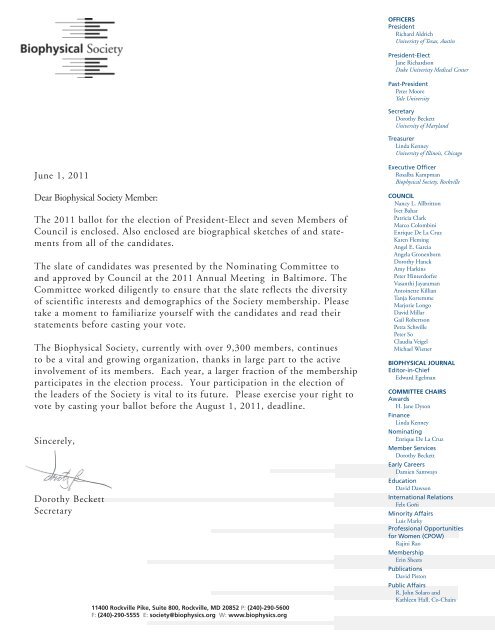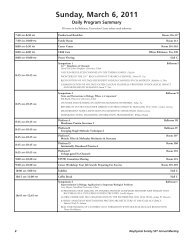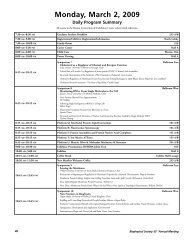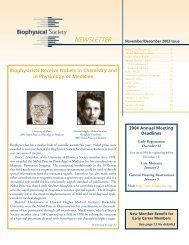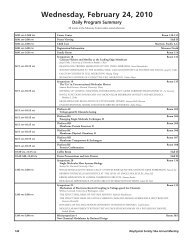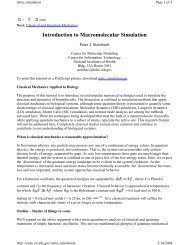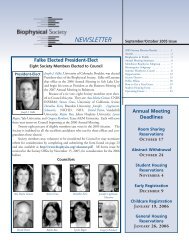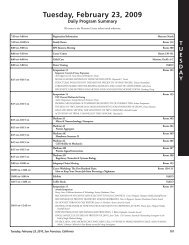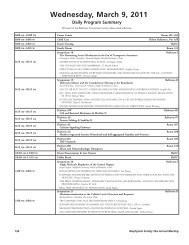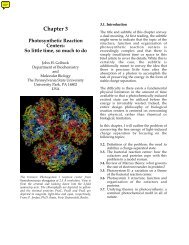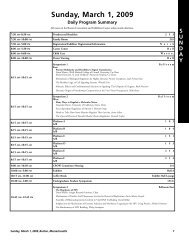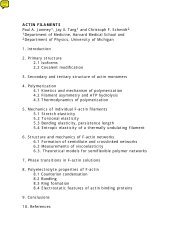June 1, 2011 Dear Biophysical Society Member: The 2011 ballot for ...
June 1, 2011 Dear Biophysical Society Member: The 2011 ballot for ...
June 1, 2011 Dear Biophysical Society Member: The 2011 ballot for ...
You also want an ePaper? Increase the reach of your titles
YUMPU automatically turns print PDFs into web optimized ePapers that Google loves.
OFFICERS<br />
President<br />
Richard Aldrich<br />
Univeristy of Texas, Austin<br />
President-Elect<br />
Jane Richardson<br />
Duke Univeristy Medical Center<br />
Past-President<br />
Peter Moore<br />
Yale University<br />
Secretary<br />
Dorothy Beckett<br />
University of Maryland<br />
Treasurer<br />
Linda Kenney<br />
University of Illinois, Chicago<br />
<strong>June</strong> 1, <strong>2011</strong><br />
<strong>Dear</strong> <strong>Biophysical</strong> <strong>Society</strong> <strong>Member</strong>:<br />
<strong>The</strong> <strong>2011</strong> <strong>ballot</strong> <strong>for</strong> the election of President-Elect and seven <strong>Member</strong>s of<br />
Council is enclosed. Also enclosed are biographical sketches of and statements<br />
from all of the candidates.<br />
<strong>The</strong> slate of candidates was presented by the Nominating Committee to<br />
and approved by Council at the <strong>2011</strong> Annual Meeting in Baltimore. <strong>The</strong><br />
Committee worked diligently to ensure that the slate reflects the diversity<br />
of scientific interests and demographics of the <strong>Society</strong> membership. Please<br />
take a moment to familiarize yourself with the candidates and read their<br />
statements be<strong>for</strong>e casting your vote.<br />
<strong>The</strong> <strong>Biophysical</strong> <strong>Society</strong>, currently with over 9,300 members, continues<br />
to be a vital and growing organization, thanks in large part to the active<br />
involvement of its members. Each year, a larger fraction of the membership<br />
participates in the election process. Your participation in the election of<br />
the leaders of the <strong>Society</strong> is vital to its future. Please exercise your right to<br />
vote by casting your <strong>ballot</strong> be<strong>for</strong>e the August 1, <strong>2011</strong>, deadline.<br />
Sincerely,<br />
Dorothy Beckett<br />
Secretary<br />
11400 Rockville Pike, Suite 800, Rockville, MD 20852 P: (240)-290-5600<br />
F: (240)-290-5555 E: society@biophysics.org W: www.biophysics.org<br />
Executive Officer<br />
Rosalba Kampman<br />
<strong>Biophysical</strong> <strong>Society</strong>, Rockville<br />
COUNCIL<br />
Nancy L. Allbritton<br />
Ivet Bahar<br />
Patricia Clark<br />
Marco Colombini<br />
Enrique De La Cruz<br />
Karen Fleming<br />
Angel E. Garcia<br />
Angela Gronenborn<br />
Dorothy Hanck<br />
Amy Harkins<br />
Peter Hinterdorfer<br />
Vasanthi Jayaraman<br />
Antoinette Killian<br />
Tanja Kortemme<br />
Marjorie Longo<br />
David Millar<br />
Gail Robertson<br />
Petra Schwille<br />
Peter So<br />
Claudia Veigel<br />
Michael Wiener<br />
BIOPHYSICAL JOURNAL<br />
Editor-in-Chief<br />
Edward Egelman<br />
COMMITTEE CHAIRS<br />
Awards<br />
H. Jane Dyson<br />
Finance<br />
Linda Kenney<br />
Nominating<br />
Enrique De La Cruz<br />
<strong>Member</strong> Services<br />
Dorothy Beckett<br />
Early Careers<br />
Damien Samways<br />
Education<br />
David Dawson<br />
International Relations<br />
Felx Goñi<br />
Minority Affairs<br />
Luis Marky<br />
Professional Opportunities<br />
<strong>for</strong> Women (CPOW)<br />
Rajini Rao<br />
<strong>Member</strong>ship<br />
Erin Sheets<br />
Publications<br />
David Piston<br />
Public Affairs<br />
R. John Solaro and<br />
Kathleen Hall, Co-Chairs
<strong>2011</strong> Nominees <strong>for</strong> President-Elect<br />
(Vote <strong>for</strong> One)<br />
Paul H. Axelsen<br />
MD<br />
Professor of Pharmacology,<br />
Biochemistry and Biophysics,<br />
and Medicine<br />
University of Pennsylvania<br />
Research interests: Protein-lipid interactions, molecular recognition and<br />
structure-based drug design, protein misfolding and amyloidogenesis.<br />
Education: B.S., Biochemistry, University of Minnesota, 1978; M.D., Mayo<br />
School of Medicine, 1982 (University of Washington, 1981-1982).<br />
Summary of Professional Experience: Postdoctoral fellowships, Mayo<br />
Graduate School of Medicine, 1982-1987; Staff Scientist, Mayo Graduate<br />
School of Medicine, 1987-1993; Assistant, Associate, and Full Professor<br />
(with tenure), Departments of Pharmacology, Biochemistry and Biophysics,<br />
and Medicine, University of Pennsylvania, 1993-present; Visiting Scholar,<br />
Weizmann Institute of Science, 1992-1993; Visiting Scholar, University of<br />
Colorado, 2008-2009.<br />
Awards, Honors and Activities: B.S. Summa cum laude, 1978; Joseph<br />
Collins Foundation Scholar, 1979-82; General Mills Clinician Scholar, 1988;<br />
Lucille P. Markey Scholar in Biomedical Science, 1989-1995; Zenith Fellows<br />
Award, Alzheimer’s Association, 2006-2008; Distinguished Faculty Award,<br />
University of Pennsylvania Graduate Group in Pharmacological Sciences,<br />
2010.<br />
National Scientific Activities: Physical Biochemistry Study Section<br />
1999 & 2004, Pharmacology, Biophysics, and MD-PhD Training Study<br />
Section 1999-2003, <strong>Biophysical</strong> Sciences Special Study Section <strong>for</strong> <strong>Member</strong><br />
Applications 2000, Bioterrorism & <strong>The</strong>rapeutics, Biodefense and Emerging<br />
Infectious Diseases Study Section 2002-2003, Biophysics and <strong>Biophysical</strong><br />
Chemistry Study Section 2004, Biochemistry and Biophysics of Membranes<br />
Study Section 2006-2009, Biophysics of Neural Systems Study Section 2007,<br />
College of CSR Reviewers, 2010-pres, National Scientific Advisory Council,<br />
American Federation <strong>for</strong> Aging Research, 2008-pres.<br />
Candidate’s Statement: <strong>The</strong> <strong>Biophysical</strong> <strong>Society</strong> is strong and vigorous in<br />
these tough economic times because its leadership has remained focused on its<br />
core purposes: the promotion of scientific discovery and the exchange of ideas<br />
through meetings, publications, and education. As president of the <strong>Society</strong>, I<br />
would place highest priority on maintaining this focus.<br />
However, we are facing a crisis of declining support <strong>for</strong> scientific research<br />
that undermines our core purposes. We all know gifted colleagues <strong>for</strong><br />
whom the pursuit of research support has <strong>for</strong>cibly displaced their pursuit of<br />
discovery. We all know gifted students who decide against careers in science<br />
because they see that so many mid-career scientists are hamstrung by a lack of<br />
research support. <strong>The</strong> decline in support began be<strong>for</strong>e the current economic<br />
difficulties, but tough economic times have made the scientific crisis worse.<br />
Under these circumstances, the <strong>Biophysical</strong> <strong>Society</strong> should make greater<br />
ef<strong>for</strong>ts to educate government policymakers about how research is conducted,<br />
and how it is funded. We must convince them that scientific investment is<br />
essential to our competitiveness, our business climate, our health, and our<br />
security. We must advise them on how to make strategic investments in<br />
science with limited resources, while avoiding policies that squander what has<br />
been built, and the talents of those who have been trained.<br />
<strong>The</strong> <strong>Biophysical</strong> <strong>Society</strong> is in a position to lead in the development of a<br />
model <strong>for</strong> sustainable scientific enterprise in which there is balanced support<br />
<strong>for</strong> all of the components that are necessary <strong>for</strong> progress: the cultivation of<br />
interest in science among schoolchildren, research training in our colleges and<br />
universities, the establishment of new independent investigators, attractive<br />
options <strong>for</strong> career scientists, and stable support <strong>for</strong> established independent<br />
investigators. As President of the <strong>Biophysical</strong> <strong>Society</strong>, I would promote<br />
ef<strong>for</strong>ts to educate government policymakers about the nature and importance<br />
of scientific research, and about how to provide balanced support through<br />
rational public policies.<br />
<strong>Biophysical</strong> <strong>Society</strong> Activities: <strong>Society</strong> member since 1986; Chair, 1998<br />
National Meeting workshop; Chair, Membrane Structure and Assembly<br />
Subgroup, 2002; <strong>Member</strong>, Program Committee, 2003-2004; <strong>Member</strong>,<br />
<strong>Biophysical</strong> Journal Editorial Board, 2004-2010; Council, 2005-2008;<br />
Executive Board, 2007-2009; Chair, Nominating Committee, 2008;<br />
<strong>Member</strong>, Finance Committee, 2009-pres; Attended every national meeting<br />
since 1990 (including Kansas City!).<br />
<strong>Biophysical</strong> <strong>Society</strong> <strong>2011</strong> Ballot
<strong>2011</strong> Nominees <strong>for</strong> President-Elect<br />
Francisco<br />
Bezanilla<br />
PhD<br />
Professor, Biochemistry and<br />
Molecular Biophysics;<br />
Lillian Eichelberger Professor,<br />
University of Chicago<br />
Research Interests: Biophysics of excitability, structure-function relation in<br />
voltage- dependent membrane transport: ion channels and transport proteins.<br />
Education: B.S. Biology Catholic University, Santiago, Chile 1964; M.S.<br />
Biophysics Catholic University, Santiago, Chile, 1967; PhD Biophysics<br />
Catholic University, Santiago, Chile 1968; Postdoctoral Biophysics, Laboratory<br />
of Biophysics, NINCDS, NIH 1969; Postdoctoral Physiology, Dept. of<br />
Physiol., Univ. of Rochester, NY 1969-71.<br />
Summary of Professional Experience: Assistant Professor, Department<br />
of Biology, Faculty of Sciences, University of Chile, 1972-1974; Research<br />
Associate, Department of Physiology, University of Rochester School of<br />
Medicine, 1974; Professor, Department of Biology, Faculty of Sciences,<br />
University of Chile, 1974-1977; Professor of Neuroscience, Department of<br />
Physiology, UCLA, 1977-2005; Professor, Institute <strong>for</strong> Molecular Pediatric<br />
Sciences and Dept. of Biochemistry and Molecular Biology, University of<br />
Chicago 2006–present.<br />
Awards, Honors and Activities: Professor Rosenblueth Lecture (I.P.N.,<br />
Mexico) 1977 ; Council <strong>Member</strong>, <strong>Society</strong> of General Physiologists 1985-<br />
1987; Secretary of SOBLA, 1986-1987; <strong>Society</strong> of General Physiologists<br />
Plenary Lecturer ,1990; American Physiological <strong>Society</strong> Annual Lecturer 1994;<br />
Susumu Hagiwara Professor of Neuroscience 1995; Annual Review Prize<br />
Lecture, <strong>The</strong> Physiological <strong>Society</strong>, U.K. 2000; Elected to the Latin American<br />
Academy of Sciences, 2002; Elected to the United States Academy of Sciences<br />
2006; Doctor Honoris Causa University of Antwerp, Belgium 2007; Lillian<br />
Eichelberger Cannon Professor 2008.<br />
<strong>Biophysical</strong> <strong>Society</strong> Activites: <strong>Society</strong> member since 1980; Council, 1983-<br />
1986; Executive Board, 1984-1986; <strong>Biophysical</strong> Journal Editorial Board,<br />
ending 1982; Kenneth S. Cole Award, 1990; Fellow of the <strong>Biophysical</strong><br />
<strong>Society</strong>, 1999; <strong>Biophysical</strong> Journal Editorial Board, 2007-2010; Committee<br />
on <strong>The</strong>matic Meetings, 2010-present<br />
Candidate’s Statement: One of my first experiences when I came to the US<br />
was the attendance to the <strong>Biophysical</strong> <strong>Society</strong> Meeting in 1970. <strong>The</strong>re I met<br />
most of the biophysicists working on membrane excitability -the precursors of<br />
the now ubiquitous and monumental ion channel crowd- and <strong>for</strong> this recently<br />
arrived postdoc, some of them converted from names in books to human<br />
beings. <strong>The</strong> free exchange of ideas I saw, including some interesting and<br />
heated discussions, shaped <strong>for</strong> me the meaning and purpose of the <strong>Society</strong>. As<br />
a beginning scientist this was a fulfilling experience. At that time, unlike today,<br />
the <strong>Society</strong> was small and participation was easier. However, I believe that it<br />
is still possible that the <strong>Society</strong> emphasize the participation of young biophysicists,<br />
as <strong>for</strong> example, giving them preference in oral presentations during the<br />
meeting. A fundamental function of our <strong>Society</strong> is to disseminate Biophysics<br />
and a way to do that is facilitating the incorporation of young scientists. This<br />
can be helped by expanding existing plans of the <strong>Society</strong>, such as travel grants<br />
<strong>for</strong> students and also <strong>for</strong>eign members. In this respect, an important aspect is<br />
expansion of the facilities <strong>for</strong> job searching. <strong>The</strong> <strong>Society</strong> has grown so large<br />
that the different sub-specialties of Biophysics rarely communicate between<br />
them. Traditionally much progress has been made possible by the interaction<br />
of apparently dissimilar disciplines, in that spirit I would like to promote such<br />
exchange by organizing joint sessions during the meetings and also expanding<br />
tutorial sessions. This is particularly relevant <strong>for</strong> new emerging techniques, an<br />
important topic during our meetings. <strong>The</strong> interaction of sub-disciplines and<br />
emerging techniques should be emphasized not only during the annual meeting<br />
but also in the <strong>Biophysical</strong> <strong>The</strong>matic Meetings carried on regularly by the<br />
<strong>Society</strong>. <strong>The</strong> <strong>Biophysical</strong> Journal, which has been an excellent communication<br />
means <strong>for</strong> us members, could also be encouraged to help in this aspect of the<br />
<strong>Society</strong> exchange between the different fields of Biophysics by, <strong>for</strong> example,<br />
implementing subject-related issues or sections. Communications these days<br />
are cheap, easy to implement and fast. <strong>The</strong>re<strong>for</strong>e wireless communication<br />
should be made available free to all registered participants during our annual<br />
meetings. <strong>The</strong> <strong>Society</strong> presence in Capitol Hill has a long tradition and we<br />
should continue and rein<strong>for</strong>ce our policies in Washington DC, especially in<br />
these difficult financial times <strong>for</strong> Science.<br />
<strong>Biophysical</strong> <strong>Society</strong> <strong>2011</strong> Ballot
<strong>2011</strong> Nominees <strong>for</strong> Council<br />
(Vote <strong>for</strong> Seven)<br />
Robert H. Chow<br />
MD, PhD<br />
Associate Professor of<br />
Physiology & Biophysics,<br />
Zilkha Neurogenetic Institute<br />
Keck School of Medicine<br />
University of Southern<br />
Cali<strong>for</strong>nia<br />
Research Interests: Molecular control of exocytosis and endocytosis, synaptic<br />
transmission, amperometry, membrane capacitance measurements,<br />
single-molecule techniques, total internal reflection fluorescence microscopy,<br />
super-resolution microscopy.<br />
Education: BA Biology, Brown University, 1981; MD, PhD Physiology,<br />
Univ. of Pennsylvania, 1988; Internal Medicine Residency, Univ. of Colorado,<br />
1988-1990; Postdoc Fellow, Max Planck Institute <strong>for</strong> <strong>Biophysical</strong> Chemistry,<br />
Germany, 1990-1995.<br />
Summary of Professional Experience: Lecturer/Senior Lecturer, Univ.<br />
of Edinburgh, Dept of Physiology, 1996-1999; Associate Professor, Univ.<br />
of Southern Cali<strong>for</strong>nia, Keck School of Medicine, Dept. of Physiology &<br />
Biophysics, 2000-present.<br />
Special Accomplishments: Medical Scientist Training Program Fellowship,<br />
1981-1988; Grass Foundation Fellow, 1984; Alexander von Humboldt<br />
Research Fellowship, 1991–1992; Howard Hughes Physician Postdoctoral<br />
Fellowship, 1993–1995; Sir Henry Wellcome Innovative Research Award,<br />
1997–1999; Human Frontiers Science Program Research Grant, 2001–2003;<br />
Founded and served as first Head of the Membrane Biology Interdisciplinary<br />
Research Group (IDG) at Univ. of Edinburgh; Founded the Junior Academics<br />
Meeting on Exocytosis and Endocytosis at Univ. of Edinburgh.<br />
<strong>Biophysical</strong> <strong>Society</strong> Activities: <strong>Society</strong> member since 1987; founded and<br />
served as first Chairman of the Exocytosis and Endocytosis Subgroup, 2003;<br />
Editorial Board of <strong>Biophysical</strong> Journal, 2005–2008.<br />
Other Scientific Societies: American Diabetes Association.<br />
Candidate’s Statement: <strong>The</strong> <strong>Biophysical</strong> <strong>Society</strong> annual meeting has always<br />
been the most important venue <strong>for</strong> the work from my own laboratory. I have<br />
been active in promoting our <strong>Society</strong> to the broader community by creating a<br />
subgroup on the topic of exocytosis and endocytosis, and I have served on the<br />
editorial board of the <strong>Society</strong> journal. <strong>The</strong> subgroup has grown each year since<br />
its founding about eight years ago, and it continues to attract both junior and<br />
senior scientists in the field, some of whom started to come regularly to the<br />
meeting only after the start of the subgroup. Each year, we also recognize the<br />
accomplishments of a senior scientist in the field by awarding the Sir Bernard<br />
Katz Award. I offer my energy and my vision to help maintain our <strong>Society</strong> as<br />
one of the best places to share and enjoy the fruits of our scientific endeavors.<br />
Gaudenz Danuser<br />
PhD<br />
Professor, Department<br />
of Cell Biology<br />
Harvard Medical School<br />
Research Interests: Mechanochemical regulation of cell and tissue morphogenesis,<br />
quantitative live cell imaging and computational modeling of cell<br />
dynamics.<br />
Education: Diploma, Measurement Sciences, 1993; PhD Electrical<br />
Engineering, 1997, both at ETH Zurich, Switzerland; Postdoctoral Fellowship,<br />
MBL, Woods Hole, 1997–1999.<br />
Summary of Professional Experience: Instructor in Biomechanics, ETH<br />
Zurich, 1999–2001; Assistant Professor of Cellular Biomechanics, ETH<br />
Zurich, 2001–2003; Assistant, Associate, Full Professor (2003–2009) of<br />
Cell Biology, <strong>The</strong> Scripps Research Institute, La Jolla, CA; Professor of Cell<br />
Biology, Harvard Medical School, Boston, MA, 2009–present; Faculty of the<br />
Physiology Course (2009– 2010), Founding Course Director, Computational<br />
Image Analysis in Cellular and Developmental Biology (<strong>2011</strong>– present) MBL.<br />
Editorial Boards, IEEE Transaction on Image Processing (2004–2008), J. Cell<br />
Biology (2010– present), J. Cell Science (<strong>2011</strong>–present).<br />
Special Accomplishments: HFSP Young Investigator Award, 2002–2005;<br />
Appointed <strong>Member</strong> NIH study sections MI and EBIT, 2008–present; Nikon<br />
Fellow, MBL, 2008; Michael and Kate Bárány Award, <strong>Biophysical</strong> <strong>Society</strong>,<br />
2009. Trans<strong>for</strong>mative R01 Award by NIH Director’s office, 2009–2014.<br />
<strong>Biophysical</strong> <strong>Society</strong> Activities: <strong>Society</strong> member since 2002; Editorial Board,<br />
<strong>Biophysical</strong> Journal, 2004–2008.<br />
Candidate’s Statement: If elected, I will bring to the <strong>Society</strong>’s agenda three<br />
topics that I feel are important <strong>for</strong> our community: First, the <strong>Society</strong> should<br />
more actively promote interdisciplinary team science. All too often decisions<br />
on graduation, hiring, or tenure appointments rely on antiquated views that<br />
intellectual leadership is reflected by work as an individual rather than participation<br />
in teams. I would like to help launch initiatives that advocate the<br />
recognition of collaborations, joint authorships and multi-investigator grants.<br />
Second, the <strong>Society</strong> should more actively communicate the value of science<br />
as the ultimate generator of innovation. I would like to participate in committee<br />
work that increases the visibility of science in the public and promotes<br />
science as a target <strong>for</strong> economic investment. Third, science is a great vehicle to<br />
integrate people across the boundaries of nationality, ethnicity, and religion.<br />
I would like to help launch initiatives that make use of the <strong>Society</strong>’s broad<br />
membership to reach out to scientists in politically, economically, and socially<br />
strained regions of the world.<br />
<strong>Biophysical</strong> <strong>Society</strong> <strong>2011</strong> Ballot
<strong>2011</strong> Nominees <strong>for</strong> Council<br />
Nathan Dascal<br />
PhD<br />
Professor of Physiology,<br />
Department of Physiology<br />
and Pharmacology, Sackler<br />
School of Medicine, Tel Aviv<br />
University, Israel<br />
Michael A.<br />
Ferenczi<br />
PhD<br />
Professor of Physiological<br />
Sciences, National Heart and<br />
Lung Institute<br />
Imperial College London, UK<br />
Research Interests: Signal transduction via G protein coupled receptors and<br />
G proteins; ion channel biophysics; modulation of neuronal and cardiac K +<br />
and Ca 2+ channels by G proteins and protein kinases. Methodologies: electrophysiology,<br />
protein biochemistry, imaging and FRET, kinetic modeling.<br />
Educational Experience: B.Sc., St. Petersburg University, Russia, 1974; M.<br />
Sc., Tel Aviv University, Israel, 1979; Ph. D., Tel Aviv University, 1983;<br />
Postdoctoral Fellowship, Cali<strong>for</strong>nia Institute of Technology, 1984–1985.<br />
Professional Experience: Lecturer, Sackler School of Medicine, Tel Aviv<br />
University, Israel, 1983–1987; Senior Lecturer, 1987–1991; Associate<br />
Professor; 1991–1996; Professor, 1996-present.<br />
Special Accomplishments: Fulbright Postdoctoral Fellowship (1984–1985);<br />
Myron R. Bantrell Postdoctoral Fellowship (1984–1985); <strong>The</strong> Juludan Prize<br />
(1994)<br />
<strong>Biophysical</strong> <strong>Society</strong> Activities: <strong>Society</strong> member since 1984; yearly participation<br />
(usually with members of my group) in the <strong>Society</strong> meetings. Participated<br />
in the organization of self-assembled sessions and chaired several sessions.<br />
<strong>Member</strong> of the Membrane Biophysics subgroup.<br />
Other Scientific Societies: <strong>Society</strong> <strong>for</strong> Neuroscience, USA; Israel <strong>Society</strong> of<br />
Physiology & Pharmacology; Israel <strong>Society</strong> <strong>for</strong> Neuroscience.<br />
Candidate’s Statement: I am a veteran member of the <strong>Society</strong>, watched it<br />
grow and participated in almost all meetings since 1984. <strong>The</strong> <strong>Society</strong> stands<br />
out in the excellent quality of its meetings and its Journal, and the high percentage<br />
of participants of the young generation. I would like to contribute<br />
from my experience to maintain and further improve these qualities, aid in<br />
future developments and progress. In particular, I would like to promote the<br />
widening of the range of issues featured at the <strong>Society</strong>’s meetings and satellite<br />
meetings, toward a tighter interplay of biophysics with physiology and cell biology,<br />
such as application of novel biophysical techniques to address important,<br />
long-standing and unresolved issues in cell and membrane signaling and regulation.<br />
As a member of the Council, I will be committed to the maintenance<br />
of quality and widening of the range of the scientific program of the Annual<br />
Meetings, support and education of young scientists, as well as to all other<br />
aspects of <strong>Society</strong>’s activity.<br />
Research Interests: Mechanism of muscle contraction in skeletal and cardiac<br />
muscle. Development of biophysical techniques <strong>for</strong> time-resolved measurements<br />
of chemical change in organised cellular systems. Application of fluorescence<br />
methods <strong>for</strong> exploring structural changes during contraction. Timeresolved<br />
low-angle X-ray diffraction techniques <strong>for</strong> cross-bridge movement.<br />
TIRF, Fluorescence life-time and FRET imaging. Disease-induced changes in<br />
muscle function.<br />
Education: B.Sc., Physiology, University College London (UCL), 1974; PhD<br />
UCL, 1978.<br />
Summary of Professional Experience: Beit Memorial Fellowship, UCL,<br />
1979-1980; Fellow of the American Muscular Dystrophy Association,<br />
Biochemistry and Biophysics, University of Pennsylvania, Philadelphia,<br />
1981-1982, then Research Assistant, 1982-1983; Scientific Staff, National<br />
Institute <strong>for</strong> Medical Research, London, 1983-2001; Professor of Physiological<br />
Sciences, Imperial College London, 2001-present; Head of Section, Molecular<br />
Medicine, National Heart and Lung Institute, 2007-present.<br />
Special Accomplishments: British <strong>Biophysical</strong> <strong>Society</strong> Executive Committee,<br />
most years since 1984; Editorial Board, Journal of Physiology, 2002–2009;<br />
European <strong>Biophysical</strong> Societies’ Association (EBSA) Executive Committee<br />
since 1996; Honorary Treasurer, 1997–2003 and 2009–present; Vice-<br />
President, then President, 2005-2009; Chairman, Organising Committee,<br />
6th European Biophysics Congress, London 2007. ESRF Review Committee,<br />
2007–present. Publications Committee of the European Biophysics Journal<br />
since 1997.<br />
<strong>Biophysical</strong> <strong>Society</strong> Activities: <strong>Society</strong> member since 1978.<br />
Other Scientific Societies: <strong>Member</strong> of the Physiological <strong>Society</strong> since 1976.<br />
As shown above, heavily involved in the European <strong>Biophysical</strong> Societies’<br />
Association.<br />
Candidate’s Statement: <strong>The</strong> interface of physics and biology provides wonderful<br />
opportunities <strong>for</strong> technology-led scientific progress. Although basic,<br />
blue-sky biophysics provides intellectual freedom, the potential application of<br />
the research <strong>for</strong> medicine and the environment adds pleasure and excitement.<br />
I am passionate to share the joys and challenges of biophysics with others, in<br />
my teaching, and <strong>for</strong>emost in EBSA, where, by means of bursaries, we bring<br />
young biophysicists from less favoured European and East European countries<br />
to EBSA Congresses and schools, <strong>for</strong> inspiration from world-famous biophysicists.<br />
I will foster greater interaction between biophysics organisations across<br />
the continents, to promote the highest quality biophysics world-wide.<br />
<strong>Biophysical</strong> <strong>Society</strong> <strong>2011</strong> Ballot
<strong>2011</strong> Nominees <strong>for</strong> Council<br />
Taekjip Ha<br />
PhD<br />
Professor, University of Illinois<br />
at Urbana-Champaign &<br />
Investigator, Howard Hughes<br />
Medical Institute<br />
Samantha Harris<br />
PhD<br />
Assistant Professor<br />
Department of Neurobiology,<br />
Physiology, and Behavior<br />
University of Cali<strong>for</strong>nia, Davis<br />
Research Interests: Single molecule biophysics and nucleic acids<br />
enzymes.<br />
Education: BS, Physics, Seoul National University, 1990; PhD, Physics,<br />
University of Cali<strong>for</strong>nia at Berkeley, 1996; Post-doctoral Fellow, Lawrence<br />
Berkeley National Laboratory, 1997, Physics, Stan<strong>for</strong>d University, 1998–<br />
2000.<br />
Summary of Professional Experience: Assistant Professor, 2000-2004,<br />
Associate Professor, 2004-2007, Professor, 2007-present, Physics, University<br />
of Illinois; Investigator, Howard Hughes Medical Institute, 2005–present;<br />
Co-director, Center <strong>for</strong> the Physics of Living Cells, University of Illinois,<br />
2008–present.<br />
Special Accomplishments: Research Innovation Award, Research<br />
Corporation, 2001; Searle Scholars Award, 2001; NSF CAREER Award,<br />
2002; Fluorescence Young Investigator Award, <strong>Biophysical</strong> <strong>Society</strong>, 2002;<br />
Cottrell Scholar, Research Corporation, 2003; Alfred P. Sloan Fellow, 2003;<br />
2004; Fellow, American Physical <strong>Society</strong>, 2005; Michael and Kate Bárány<br />
Award <strong>for</strong> Young Investigators, <strong>Biophysical</strong> <strong>Society</strong>, 2007; University<br />
Scholar, University of Illinois, 2009, Ho-Am Prize in Science, <strong>2011</strong>.<br />
<strong>Biophysical</strong> <strong>Society</strong> Activities: <strong>Society</strong> member and active participant<br />
since 1999; Recipient, Fluorescence Young Investigator Award, 2002;<br />
Awarded the Bárány Award <strong>for</strong> Young Investigators, 2007; <strong>Member</strong>,<br />
Nominating Committee, 2006; <strong>Member</strong>, Program Committee, 2007–<br />
2010; Editorial Board of <strong>Biophysical</strong> J., 2007-present; Program Chair, 54th<br />
Annual Meeting; 2009–2010; Invited talks at Workshops (2000, 2002,<br />
2006), Subgroup meetings (2002,2005,<strong>2011</strong>) and Discussion meeting<br />
(2006). Many members of my laboratory participate each year in the annual<br />
meetings with either posters or plat<strong>for</strong>m presentations.<br />
Other Scientific Societies: American Physical <strong>Society</strong>, American Chemical<br />
<strong>Society</strong>.<br />
Candidate’s Statement: <strong>Biophysical</strong> <strong>Society</strong> is my home society and I<br />
came to appreciate how democratic and <strong>for</strong>ward-looking the society leadership<br />
is through my previous services in nominating and program committees.<br />
I wish to help the <strong>Society</strong> build on its outstanding tradition and<br />
reinvent itself while maintaining continuity, which would be essential in<br />
attracting and keeping the brightest young scientists.<br />
Research Interests: Myofilament and contractile proteins, molecular mechanisms<br />
of muscle contraction, mechanisms by which mutations in contractile<br />
proteins cause hypertrophic cardiomyopathy.<br />
Education: BS, Biology, University of Illinois-Urbana Champaign, 1988;<br />
PhD, Physiology (epithelial ion transport), University of Michigan, Ann<br />
Arbor, MI, 1995; Postdoctoral training (myocardial contraction), University<br />
of Wisconsin, Madison, WI, 1996-2001.<br />
Summary of Professional Experience: Assistant Research Scientist,<br />
University of Wisconsin, Madison, WI, 2001–2003; Research Assistant<br />
Professor, University of Washington, Seattle, WA, 2003–2007; Assistant<br />
Professor, University of Cali<strong>for</strong>nia, Davis, CA, 2007-<strong>2011</strong>; Associate Professor<br />
<strong>2011</strong>–present.<br />
Special Accomplishments: Phi Beta Kappa Honor <strong>Society</strong>, 1988; American<br />
Physiological <strong>Society</strong> Caroline tum Suden Professional Opportunity Award<br />
<strong>for</strong> Meritorious Research, 1993; American Heart Association Chippewa<br />
Valley Research Award, 1998; NRSA NIH Postdoctoral Fellowship, 1999-<br />
2001; American Heart Association McClain Research Award, 2002; American<br />
Heart Association New Investigator Award, 2003; American Heart Association<br />
Scientist Development Grant, 2001–2006; American Heart Association<br />
Western Affiliates Laverna Titus Young Investigator Award, 2008. Editorial<br />
Board <strong>Member</strong>: Journal of Molecular and Cellular Cardiology, Frontiers in<br />
Cardiac Muscle Physiology.<br />
<strong>Biophysical</strong> <strong>Society</strong> Activities: <strong>Society</strong> member and active participant<br />
in Annual <strong>Biophysical</strong> <strong>Society</strong> Meetings since 1996; <strong>Member</strong> of Motility<br />
Subgroup; Motility Subgroup Speaker in 2008; Speaker and Chair, Myosin<br />
Symposium, 2009; <strong>Member</strong> of Committee on Professional Opportunities <strong>for</strong><br />
Women (CPOW) 2010–present.<br />
Other Scientific Societies: International <strong>Society</strong> of Heart Research,<br />
Contractile and Regulatory Proteins Program Committee; American Heart<br />
Association; American Physiological <strong>Society</strong>.<br />
Candidate’s Statement: <strong>The</strong> <strong>Biophysical</strong> <strong>Society</strong> provides common ground<br />
<strong>for</strong> all those wanting to know “how” things work. It is this common purpose<br />
within a vibrant diversity of research questions that makes the <strong>Biophysical</strong><br />
<strong>Society</strong> a unique and exciting <strong>for</strong>um especially suited <strong>for</strong> the cross-pollination<br />
of ideas and education across and within disciplines. As a Council member<br />
I will work to highlight the newest intersections of ideas and methodology<br />
across our varied fields while maintaining the breadth and depth of topics that<br />
make the <strong>Biophysical</strong> <strong>Society</strong> a premiere venue <strong>for</strong> presentation of the most<br />
innovative and rigorous science.<br />
<strong>Biophysical</strong> <strong>Society</strong> <strong>2011</strong> Ballot
<strong>2011</strong> Nominees <strong>for</strong> Council<br />
Marcia Levitus<br />
PhD<br />
Assistant Professor,<br />
Department of Chemistry and<br />
Biochemistry and<br />
Biodesign Institute<br />
Arizona State University<br />
Wolfgang A. Linke<br />
PhD<br />
Professor and Chair of<br />
Physiology, Ruhr University<br />
Bochum, Germany<br />
Research Interests: Development and application of fluorescence techniques<br />
to problems in biophysics, in particular con<strong>for</strong>mational dynamics in nucleic<br />
acids and proteins. Photophysical and photochemical properties of fluorescent<br />
probes in biomolecular environments.<br />
Education: BS, chemistry, University of Buenos Aires, Argentina, 1995;<br />
PhD in physical chemistry, University of Buenos Aires, Argentina, 1998;<br />
Postdoctoral fellow, University of Cali<strong>for</strong>nia Los Angeles, 1998–2000;<br />
Postdoctoral fellow, University of Cali<strong>for</strong>nia Berkeley, 2000–2004.<br />
Summary of Professional Experience: Assistant professor of chemistry and<br />
biochemistry, Arizona State University, 2005-present; Assistant professor<br />
of physics (affiliated), Arizona State University, 2006-present; <strong>Member</strong> of<br />
the center <strong>for</strong> single molecule biophysics, Biodesign Institute, Arizona State<br />
University, 2005–present.<br />
Special Accomplishments: NSF CAREER Award, 2006; Inter-American<br />
Photochemical <strong>Society</strong> Young Investigator Award, 2010.<br />
<strong>Biophysical</strong> <strong>Society</strong> Activities: <strong>Society</strong> member since 2005; <strong>Member</strong> of the<br />
Biological Fluorescence subgroup. My lab members and I are regular attendees<br />
of the Annual Meeting.<br />
Candidate’s Statement: <strong>The</strong> <strong>Biophysical</strong> <strong>Society</strong> Annual Meeting has been<br />
an invaluable venue in my career to meet colleagues and discuss exciting<br />
developments in the interface between physics and the biological sciences.<br />
<strong>The</strong> size of the conference, however, has grown to the point that it is easy<br />
to feel overwhelmed by so many options and parallel activities. I believe the<br />
biophysics community would benefit from complementing the annual society<br />
meetings with more focused thematic meetings, especially in the summer.<br />
<strong>The</strong>se smaller meetings would not only foster in-depth discussions in cutting<br />
edge fields of biophysics, but also would provide new investigators with more<br />
opportunities to interact with the leaders in these fields. Along the same lines,<br />
increasing the number of subgroups and subgroup activities would promote<br />
a more fluid interaction among members with a common interest. I also<br />
believe that the <strong>Society</strong> should increase its ef<strong>for</strong>ts in disseminating material<br />
to a broader audience through their website, and through webinars, webcasts<br />
and podcasts. <strong>The</strong>se materials can be invaluable educational tools <strong>for</strong> educators<br />
looking <strong>for</strong> resources, or <strong>for</strong> new investigators in the field looking <strong>for</strong> an<br />
introduction to a particular topic.<br />
Research Interests: Muscle mechanics, ultrastructure, and mechanosignaling;<br />
single-molecule experiments, atomic <strong>for</strong>ce microscopy, <strong>for</strong>ce spectroscopy;<br />
cytoskeletal dynamics.<br />
Education: Diploma, Biology, University of Halle-Wittenberg, Germany,<br />
1988; PhD, Physiology, University of Halle-Wittenberg, 1991; Postdoctoral<br />
Fellow, Dept. of Bioengineering, University of Washington, Seattle, 1991–<br />
1994; Habilitation, Physiology, University of Heidelberg, Germany, 1998.<br />
Summary of Professional Experience: Assistant Professor, Institute of<br />
Physiology, University of Heidelberg, 1994–2003; Visiting Professor, Dept.<br />
of Physiology and Biophysics, Mayo Clinic Rochester, 2001; Professor and<br />
Head, Physiology and Biophysics Unit, University of Muenster, Germany,<br />
2003–2009; Professor and Chair of Physiology, Ruhr University Bochum,<br />
Germany, 2009–present.<br />
Special Accomplishments: “Heisenberg” (career development) Award of<br />
the German Research Foundation, 1999–2003; Elected Executive Board<br />
<strong>Member</strong>, European <strong>Society</strong> <strong>for</strong> Muscle Research, 2009-present; Invited<br />
Fellow, European <strong>Society</strong> of Cardiology, 2010; Editorial Board, Journal of<br />
Muscle Research and Cell Motility, 2002–present; and Journal of Molecular<br />
and Cellular Cardiology, 2008–present.<br />
<strong>Biophysical</strong> <strong>Society</strong> Activities: <strong>Society</strong> member and active Annual<br />
Meeting participant since 1992. <strong>Biophysical</strong> <strong>Society</strong> International Mentor,<br />
2003–present.<br />
Other Scientific Societies: European <strong>Society</strong> <strong>for</strong> Muscle Research, German<br />
Physiological <strong>Society</strong>; German and European Societies of Cardiology,<br />
American Heart Association.<br />
Candidate’s Statement: I joined the <strong>Biophysical</strong> <strong>Society</strong> in 1992 as a young<br />
postdoctoral fellow who had just arrived in the United States from <strong>for</strong>mer<br />
Eastern Germany. Since then, the <strong>Society</strong> has been a scientific home <strong>for</strong><br />
me and the Annual Meeting always an intellectual and social highlight. As<br />
a Council member, I will work to further promote the Meeting as a most<br />
eminent venue <strong>for</strong> the exchange of ideas and methodology among scientists<br />
of diverse background. <strong>The</strong>re is no better time <strong>for</strong> biophysics than now, as the<br />
challenges abound, e.g., in moving towards a more quantitative description of<br />
complex biological systems after gathering knowledge on simpler paradigms. I<br />
will continue my ef<strong>for</strong>ts in mentoring young scientists and ensuring diversity<br />
in gender and other categories within institutions and the <strong>Biophysical</strong> <strong>Society</strong>.<br />
I look <strong>for</strong>ward to being more actively involved in the <strong>Society</strong> and Annual<br />
Meeting planning.<br />
<strong>Biophysical</strong> <strong>Society</strong> <strong>2011</strong> Ballot
<strong>2011</strong> Nominees <strong>for</strong> Council<br />
Merritt Maduke<br />
PhD<br />
Associate Professor,<br />
Department of Molecular &<br />
Cellular Physiology<br />
Stan<strong>for</strong>d University<br />
Research Interests: Molecular mechanisms of ion channels and transporters;<br />
approaches include electrophysiology, biochemistry, NMR, computational<br />
methods, and small-molecule probe development.<br />
Education: BS, Chemistry, Wheaton College, 1989; PhD, Chemistry,<br />
University of Cali<strong>for</strong>nia San Diego, 1995; Postdoctoral Associate, Brandeis<br />
University, 1995–2001.<br />
Summary of Professional Experience: Assistant Professor, Dept of<br />
Molecular & Cellular Physiology, Stan<strong>for</strong>d University, 2001–2009; Associate<br />
Professor, Dept of Molecular & Cellular Physiology, Stan<strong>for</strong>d University,<br />
2009–present.<br />
Special Accomplishments: Summa cum laude, Wheaton College, 1989;<br />
Esther Ehrman Lazard Faculty Fellow, 2003; Cranefield Award, 2007;<br />
Councilor, <strong>Society</strong> of General Physiologists, 2007–2010; Chair, Ion Channels<br />
GRC, 2010; GRC Headquarters “Hall of Fame” <strong>for</strong> Chairs who are always<br />
pleasant to work with, 2010; Editorial Board, Journal of General Physiology,<br />
2010-present; Co-Chair, American Heart Association Unified Peer Review<br />
Committee, Proteins & Crystallography, 2010-present.<br />
<strong>Biophysical</strong> <strong>Society</strong> Activities: <strong>Society</strong> member since 1995; Membrane<br />
Biophysics Subgroup, 1995–present; I have attended almost all of the past<br />
16 meetings, and my lab members present at every meeting. Committee <strong>for</strong><br />
Professional Opportunities <strong>for</strong> Women, 2010–present. Panelist: “If I Knew<br />
<strong>The</strong>n What I Know Now” career-development session, 2010. Organizer:<br />
Postdoc to Faculty Q & A: Transitions Forum and Luncheon, <strong>2011</strong>.<br />
Other Scientific Societies: <strong>Society</strong> of General Physiologists, American<br />
Chemical <strong>Society</strong>, American Heart Association, American Physiological<br />
<strong>Society</strong>, American Association <strong>for</strong> the Advancement of Science.<br />
Candidate’s Statement: <strong>The</strong> <strong>Biophysical</strong> <strong>Society</strong> is a splendid community<br />
of scientists who appreciate and pioneer quantitative approaches in biological<br />
research. As a Council <strong>Member</strong>, there are three main areas in which I would<br />
focus my ef<strong>for</strong>ts. First, to help maintain and enhance high-quality programs at<br />
the annual meeting, I will consult broadly amongst the membership regarding<br />
the diverse and interdisciplinary topics of biophysics. Second, I will continue<br />
to create and promote career-development resources, especially <strong>for</strong> young<br />
biophysicists. Finally, I will advocate <strong>for</strong> expanding the <strong>Society</strong>’s ef<strong>for</strong>ts in its<br />
Public Affairs Committee. Public appreciation and support of Biophysics is<br />
critical to sustaining the vibrant research community we know and love.<br />
Daniel L. Minor, Jr.<br />
PhD<br />
Associate Professor,<br />
Cardiovascular Research<br />
Institute (CVRI),<br />
University of Cali<strong>for</strong>nia, San<br />
Francisco, Physical Biosciences<br />
Division, Lawrence Berkeley<br />
National Laboratory<br />
Research Interests: Membrane protein structure and function. Molecular<br />
recognition. Ion channel drug development. Molecular machines.<br />
Education: B.A., Univ. of Penn., Biochemistry and Biophysics, magna cum<br />
laude, 1989; PhD Dept. of Chemistry, M.I.T, 1996; Postdoc, MRC-LMB<br />
Cambridge, England, 1996; Postdoc, HHMI, Dept. of Physiology, UCSF,<br />
1996-2000.<br />
Summary of Professional Experience: Asst. Prof., CVRI and Dept. of<br />
Biochem. & Biophys., UCSF, 2000–2007; Asst. Prof., Dept. of Cell. &<br />
Mol. Pharm., UCSF, 2002-2007; Assoc. Prof. (w/ tenure), CVRI, Depts.<br />
of Biochem. & Biophys. and Cell. & Mol. Pharm., UCSF, 2007-present;<br />
Faculty Scientist, Physical Biosciences Division, Lawrence Berkeley National<br />
Laboratory, 2009–present.<br />
Special Accomplishments: ILGWU Scholarship, 1985; Helix Prize in<br />
Biochemistry, Univ. of Penn. 1989; Phi Beta Kappa, 1989; Burroughs<br />
Wellcome HitchingsElion Fellowship, 1996; McKnight Scholar, 2001–<br />
2004; Rita Allen Scholar, 2001–2005; Alfred P. Sloan Fellow, 2002-2004;<br />
Beckman Young Investigator, 2002–2005; March of Dimes, Basil O’Connor<br />
Scholar, 2002–2004; Searle Scholar, 2002–2005; McKnight Technological<br />
Innovation Award, 2004-2006; Established Investigator, American Heart<br />
Association, 2007–<strong>2011</strong>; Fellow of the American Asthma Foundation 2010–<br />
<strong>2011</strong>; Feinberg Foundation Visiting Faculty Fellow, Weizmann Institute,<br />
Israel, <strong>2011</strong>.<br />
<strong>Biophysical</strong> <strong>Society</strong> Activities: <strong>Society</strong> member since 2001; Membrane<br />
Biophysics Subgroup <strong>Member</strong>; Chair of the Membrane Biophysics Subgroup,<br />
2010; CPOW discussion member, 2010; I and members of my laboratory are<br />
regular attendees of the Annual Meeting.<br />
Candidate’s Statement: I am grateful <strong>for</strong> the opportunity to run <strong>for</strong><br />
<strong>Biophysical</strong> <strong>Society</strong> Council. I will strive to maintain the high standards of<br />
exciting meetings that include sessions featuring scientists doing cutting edge<br />
biophysics at all career stages. In this regard, the plat<strong>for</strong>m sessions are one of<br />
the most important aspects of the meeting. <strong>The</strong>y provide a fantastic <strong>for</strong>um <strong>for</strong><br />
presentations of stimulating, new results, and are an important opportunity<br />
<strong>for</strong> students and postdocs to present their data firsthand. As biological science<br />
becomes more quantitative, the <strong>Biophysical</strong> <strong>Society</strong> has an important role as a<br />
venue <strong>for</strong> the development of both the science and the next generation of scientists<br />
and as an advocate <strong>for</strong> our shared enterprise. It would be a great honor<br />
to contribute by working directly <strong>for</strong> the <strong>Society</strong> as a Council member.<br />
<strong>Biophysical</strong> <strong>Society</strong> <strong>2011</strong> Ballot
<strong>2011</strong> Nominees <strong>for</strong> Council<br />
Jeanne M. Nerbonne<br />
PhD<br />
Alumni Endowed Professor of<br />
Molecular Biology<br />
and Pharmacology<br />
Washington University Medical<br />
School<br />
E. Michael Ostap<br />
PhD<br />
Professor of Physiology<br />
Director, Pennsylvania<br />
Muscle Institute<br />
University of Pennsylvania<br />
School of Medicine<br />
Research Interests: Molecular determinants of voltage-gated ion channel<br />
diversity and functioning in cardiac and neuronal cells; Inherited and acquired<br />
disorders of excitability in the cardiovascular and nervous systems<br />
Education: BSc, Chemistry, Framingham State College, 1974; PhD, Physical<br />
Organic Chemistry, Georgetown University, 1978; Postdoctoral Fellow,<br />
Biology, CalTech, 1979-1984.<br />
Summary of Professional Experience: Assistant-Full Professor,<br />
Pharmacology, Washington University Medical School, 1985–2001; Alumni<br />
Endowed Professor of Molecular Biology and Pharmacology, 2002-present,<br />
Professor of Biomedical Engineering and Internal Medicine (secondary),<br />
Washington University, 2006-present.<br />
Special Accomplishments: W. W. Zorbach Chemistry Prize, Georgetown<br />
University, 1978; NIH/NRSA Postdoctoral Fellowship, 1979–1981; AHA<br />
Postdoctoral Fellowship, 1981–1983; AHA Established Investigator Award,<br />
1984–1989; Editorial Board, Circulation Research, 1995–present; Founding<br />
Fellow of the American Heart Association, Basic Cardiovascular Sciences, 2001;<br />
Medical Science Graduate Student Association Keynote Speaker, University<br />
of Calgary, 2002; Neurosciences Graduate Student Organization Speaker,<br />
Baylor College of Medicine, 2003; <strong>The</strong> Rudy Clarenburg Distinguished<br />
Lecturer, Kansas State University, 2003; Neurosciences Interdisciplinary<br />
Graduate Program Speaker, Georgetown University, 2004; Associate Editor,<br />
Channels, 2006-present; Davis Heart and Lung Research Institute Discovery<br />
Series Distinguished Lecturer, Ohio State University, 2006; Distinguished<br />
Investigator Award, Washington University, 2007; Reviewing Editor, Journal<br />
of Neuroscience, 2007–present.<br />
<strong>Biophysical</strong> <strong>Society</strong> Activites: <strong>Society</strong> member since 1996.<br />
Other Scientific Societies: American Heart Association; American<br />
Physiological <strong>Society</strong>; Cardiac Electrophysiology <strong>Society</strong>; Heart Rhythm<br />
<strong>Society</strong>; <strong>Society</strong> of General Physiologists; <strong>Society</strong> <strong>for</strong> Neuroscience.<br />
Candidate’s Statement: Over the years, membership in the <strong>Biophysical</strong><br />
<strong>Society</strong> has provided great benefit to me personally, including casual/<strong>for</strong>mal<br />
interactions with colleagues at meetings, discussions at posters, and recruiting<br />
postdoctoral fellows through the Job Board. Importantly, I also recognize the<br />
impact that <strong>Society</strong> membership, meeting attendance and poster/slide presentations<br />
has on predoctoral and postdoctoral trainees. I applaud the emphasis of<br />
the <strong>Biophysical</strong> <strong>Society</strong> leadership on education, training and mentoring and I<br />
would be happy to participate in these ef<strong>for</strong>ts as a member of the Council.<br />
Research Interests: Biophysics, biochemistry, and cell biology of cell motility.<br />
Molecular motor proteins, biochemical kinetics, single molecule biophysics.<br />
Education: BS, Chemistry, Illinois State University, 1988; PhD,<br />
Biochemistry, Molecular Biology, and Biophysics, University of Minnesota,<br />
1993; Postdoctoral Fellow, Johns Hopkins University School of Medicine,<br />
1993–1996.<br />
Summary of Professional Experience: Assistant Professor of Physiology,<br />
1997–2003; Associate Professor of Physiology, 2003–2009; Professor of<br />
Physiology, 2009–present; Director, Pennsylvania Muscle Institute, University<br />
of Pennsylvania School of Medicine, 2010–present.<br />
Special Accomplishments: Damon Runyon-Walter Winchell Post-Doctoral<br />
Fellowship, 1994–1996; Mary L. Smith Award <strong>for</strong> Cardiovascular Research,<br />
1999; Established Investigator of the American Heart Association, 2002–<br />
2005; Deans Award <strong>for</strong> Excellence in Graduate Training, 2006; Director T32<br />
Training Program in Muscle Biology and Disease, 2006–present; Vice Chair,<br />
Gordon Conference on Muscle & Molecular Motors, <strong>2011</strong>.<br />
<strong>Biophysical</strong> <strong>Society</strong> Activities: <strong>Society</strong> member since 1993; Co-Chair of<br />
Motility Subgroup, 2003; Motility Subgroup Speaker, 2007; <strong>Biophysical</strong><br />
<strong>Society</strong> Symposium Speaker, 2009; Editorial Board, <strong>Biophysical</strong> Journal,<br />
2007–present.<br />
Other Scientific Societies: American <strong>Society</strong> <strong>for</strong> Cell Biology.<br />
Candidate’s Statement: Our <strong>Society</strong> is the premier organization <strong>for</strong> the dissemination<br />
of state-of-the-art biophysical research. <strong>The</strong>re<strong>for</strong>e, the council’s<br />
number-one priority must be to maintain this world-class distinction by<br />
ensuring the quality and significance of its meetings, publications, and education<br />
initiatives. We will accomplish this goal by highlighting the historic<br />
strengths of our membership, while working to bring our rigorous standards<br />
and new technologies to emerging fields of biology and biomedicine. <strong>The</strong><br />
latter is especially true as changes in research funding opportunities (national<br />
and international) are pointing us in new research directions. Having served<br />
as chair of the Motility Subgroup and as a member of the <strong>Biophysical</strong> Journal<br />
Editorial Board, I am excited about the opportunity to play a new role in supporting<br />
our vibrant <strong>Society</strong>.<br />
<strong>Biophysical</strong> <strong>Society</strong> <strong>2011</strong> Ballot
<strong>2011</strong> Nominees <strong>for</strong> Council<br />
Douglas N.<br />
Robinson<br />
PhD<br />
Associate Professor<br />
of Cell Biology<br />
Johns Hopkins University<br />
School of Medicine<br />
James R.<br />
Williamson<br />
PhD<br />
Professor, Dean of Graduate and<br />
Postdoctoral Studies, <strong>The</strong> Skaggs<br />
Institute <strong>for</strong> Chemical Biology<br />
and <strong>The</strong> Scripps Research<br />
Institute<br />
Research Interests: Actin crosslinkers, cell mechanics, cell shape change,<br />
cellular mechanosensing, cytokinesis, cytoskeleton, development, imaging,<br />
molecular motors, myosin.<br />
Education: BS, Biology, Purdue University, 1991; PhD, Yale University<br />
School of Medicine, 1997; Postdoctoral Fellowship, Stan<strong>for</strong>d University,<br />
1997–2001.<br />
Summary of Professional Experience: Assistant Professor of Cell Biology,<br />
Johns Hopkins School of Medicine, 2001-2008; Associate Professor of<br />
Cell Biology, Johns Hopkins School of Medicine, 2008-present; Secondary<br />
appointments in the Departments of Pharmacology and Molecular Sciences,<br />
Johns Hopkins School of Medicine and Chemical and Biomolecular<br />
Engineering, Johns Hopkins University Whiting School of Engineering.<br />
Special Accomplishments: Phi Beta Kappa, Purdue University Chapter,1991;<br />
Damon Runyon-Walter Winchell Cancer Research Fund Postdoctoral<br />
Fellow, 1997–2000; Burroughs-Wellcome Fund Career Award in the<br />
Biomedical Sciences, 2000–2004; Arnold and Mabel Beckman Foundation<br />
Young Investigator Award, 2003–2006; American Cancer <strong>Society</strong> Research<br />
Scholar Award, 2007-<strong>2011</strong>; Editorial Board <strong>Member</strong> of <strong>Biophysical</strong> Journal,<br />
since 2009; Editorial Board <strong>Member</strong> of Current Biology, since 2010; Editorial<br />
Board <strong>Member</strong> of Cytoskeleton, since <strong>2011</strong>.<br />
<strong>Biophysical</strong> <strong>Society</strong> Activities: <strong>Society</strong> member since 2004; Editorial Board<br />
<strong>Member</strong> of <strong>Biophysical</strong> Journal, since 2009; Chair of the Symposium on Cell<br />
and Tissue Mechanics and Modeling, <strong>2011</strong>; Many members of my group and<br />
I regularly attend and present at the Annual Meeting.<br />
Other Scientific Societies: American <strong>Society</strong> <strong>for</strong> Cell Biology.<br />
Candidate’s Statement: I joined the <strong>Biophysical</strong> <strong>Society</strong> in 2004 because<br />
my cell biology research was evolving towards a more biophysical emphasis.<br />
As an Editorial Board <strong>Member</strong> of <strong>Biophysical</strong> Journal, I have enjoyed the role<br />
of fostering and improving papers as they progress through the peer-review<br />
process. I have always appreciated the ef<strong>for</strong>ts of the <strong>Biophysical</strong> <strong>Society</strong> to<br />
increase diversity in science. <strong>The</strong>se ef<strong>for</strong>ts have helped inspire me to do more<br />
along these lines in my own lab where I established an outreach ef<strong>for</strong>t to<br />
mentor underprivileged high school students from Baltimore. Furthermore,<br />
during these unsettled economic times, the <strong>Society</strong> plays an important role<br />
in communicating the mission of science to our government leaders and the<br />
general public. Cultivating diversity in science and promoting outreach will<br />
be of particular interest to me if I am elected as a Council member.<br />
Research Interests: We study the structure, dynamics and assembly of ribonucleoprotein<br />
complexes using a wide variety of biophysical methods, including<br />
fluorescence, mass spectrometry, electron microscopy, x-ray crystallography,<br />
and NMR. Particular areas of focus include ribosome assembly, 3’-UTR<br />
binding proteins from C. elegans, RNA binding proteins regulating T-cell<br />
activation, and Rev-host factor complexes involved in HIV RNA transport.<br />
Education: B.S. in Chemistry Mount Union College 1981; PhD in<br />
Chemistry Stan<strong>for</strong>d University, 1988; postdoctoral work at the University<br />
of Colorado.<br />
Summary of Professional Experience: Assistant/Associate Professor in the<br />
Department of Chemistry at MIT, 1990-1997; Professor in the Department<br />
of Molecular Biology at <strong>The</strong> Scripps Research Institute, 1998-present;<br />
Associate Dean, 2001-2007 and Dean of Graduate Studies, 2008-present<br />
at <strong>The</strong> Kellogg School of Science and Technology at <strong>The</strong> Scripps Research<br />
Institute.<br />
Special Accomplishments: American Academy of Arts and Sciences, 2010;<br />
Camille Dreyfus Teacher-Scholar Award, 1995; Alfred P. Sloan Fellow,<br />
1995; Rita Allen Scholar, 1994; Searle Scholar Award, 1991; Associate<br />
Editor, Annual Reviews of Biophysics, 2003-present; Board of Editors, ACS<br />
Chemical Biology, 2006-present; presently on Editorial Boards <strong>for</strong> Chemistry<br />
and Biology, RNA, Molecular Cell, Structure, Biopolymers, BMC-Biology.<br />
<strong>Biophysical</strong> <strong>Society</strong> Activities: <strong>Society</strong> member since 2002; Chair, Annual<br />
Meeting Program Committee, <strong>2011</strong>; Program Committee, 2010-2012<br />
Candidate’s Statement: This is an exciting time in Biophysics, and my own<br />
research is moving in a direction that is more centrally biophysical in approach.<br />
Through the annual meeting, the <strong>Society</strong> is reaching out to include new and<br />
emerging disciplines, and it is critically important that the <strong>Society</strong> continues to<br />
evolve. Through service on the Council, I am willing to help foster the careers<br />
of younger scientists, and to promote and advocate <strong>for</strong> the <strong>Society</strong>.<br />
<strong>Biophysical</strong> <strong>Society</strong> <strong>2011</strong> Ballot
<strong>2011</strong> Nominees <strong>for</strong> Council<br />
David T. Yue<br />
MD, PhD<br />
Associate Professor<br />
of Cell Biology<br />
Johns Hopkins University<br />
School of Medicine<br />
Research Interests: Ca 2+ and calmodulin signaling; ion channels, with<br />
emphasis on Ca 2+ and Na channels, biological regulation, genetic diversity,<br />
biophysical mechanisms, structure-function relations, and structure; genetically<br />
encoded optical biosensors and actuators; FRET-based live-cell imaging.<br />
Education: BA, Magna Cum Laude, Biochemical Sciences, Harvard<br />
University, 1979; MD, Johns Hopkins University School of Medicine,<br />
1987; PhD, Biomedical Engineering, Johns Hopkins University School<br />
of Medicine, 1987; Postdoctoral Fellowship, Johns Hopkins University,<br />
Division of Cardiology, 1987–1989.<br />
Summary of Professional Experiences: Assistant Professor, Department of<br />
Biomedical Engineering, Johns Hopkins University, 1989–1993; Associate<br />
Professor, Department of Biomedical Engineering, Johns Hopkins University,<br />
1993–1999; Professor, Department of Biomedical Engineering, Johns<br />
Hopkins University, 1999–present; Professor, Department of Neuroscience,<br />
Johns Hopkins University, 1999–present.<br />
Awards, Honors, and Activities: Johns Hopkins University Alumni<br />
Excellence in Teaching Award, 2009; NIH MERIT award, 2004; Board of<br />
Scientific Counsellors, NINDS, 2003-2006; Presidential Faculty Fellowship,<br />
NSF, 1992–1997; Established Investigator Award, American Heart<br />
Association, 1990–1995; Pfizer Scholar New Faculty Award, 1988–1990;<br />
David Israel Macht Research Award, 1987, Johns Hopkins University.<br />
<strong>Biophysical</strong> <strong>Society</strong> Activities: <strong>Society</strong> member since 1987; Chair, Membrane<br />
Biophysics Subgroup, 2006; Kenneth S. Cole Award, Membrane Biophysics<br />
Subgroup, <strong>2011</strong>; Chair and Speaker, Symposium on Ca 2+ -regulation<br />
of channels, <strong>Biophysical</strong> <strong>Society</strong> Annual Meeting, <strong>2011</strong>; Editorial Board<br />
<strong>Member</strong>, <strong>Biophysical</strong> Journal, 2010-present.<br />
Other Scientific Societies: <strong>Society</strong> <strong>for</strong> Neuroscience.<br />
Candidate’s Statement: <strong>The</strong> <strong>Biophysical</strong> <strong>Society</strong> has been a treasured scientific<br />
home base since graduate school. For me, this society fosters and represents<br />
the best in mechanistic biological science. My goals as a council member<br />
are there<strong>for</strong>e three-fold: (1) To ensure that the society continues to draw the<br />
highest levels of mechanistic biological science; (2) To improve the reach of<br />
the society to attract emerging biological fields of the future; (3) To expand<br />
the enticements <strong>for</strong> younger generations of scientists to join the ranks of those<br />
committed to mechanistic biological discovery.<br />
<strong>Biophysical</strong> <strong>Society</strong> <strong>2011</strong> Ballot


